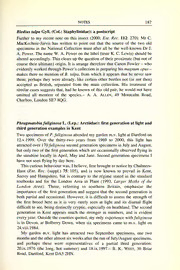
Phragmatobia fuliginosa L. (Lep.: Arctiidae): First generation at light and third generation examples in Kent PDF
Preview Phragmatobia fuliginosa L. (Lep.: Arctiidae): First generation at light and third generation examples in Kent
NOTES 187 Bledius talpa Gyll. (Col.: Staphylinidae): a postscript Further to my recent note on this insect (2000, Ent. Rec. 112: 270): Mr C. MacKechnie-Jarvis has written to point out that the source of the two old specimens in the National Collection must after all be the well-known Dr J. A. Power. The name W. A. Power on the label (teste K. C. Lewis) should be altered accordingly. This clears up the question of their proximate (but not of course their ultimate) origin. It is strange therefore that Canon Fowler - who evidently worked through Power's collection in preparing his magnum opus - makes there no mention of B. talpa, from which it appears that he never saw them; perhaps they were already, like certain other beetles not (or not then) accepted as British, separated from the main collection. His treatment of similar cases suggests that, had he known of this old pair, he would not have omitted all mention of the species- A. A. Allen, 49 Montcalm Road, Charlton, London SE7 8QG. Phragmatobiafuliginosa L. (Lep.: Arctiidae): first generation at light and third generation examples in Kent Two specimens ofP fuliginosa attended my garden m.v. light at Dartford on . 12.V.1999. Over the thirty-two years from 1969 to 2000, this light has attracted over HOfulignosa second generation specimens in July and August, but only two of the first generation which are occasionally observed flying in the sunshine locally in April, May and June. Second generation specimens I have not seen flying by day here. This curious behaviour was, I believe, first brought to notice by Chalmers- Hunt (Ent. Rec. (suppl.) 75: 105), and is now known to prevail in Kent, Surrey and Hampshire, but is contrary to the regime stated in the standard textbooks and for the London Area in Plant (1993, Larger Moths of the London Area). These, referring to southern Britain, emphasise the importance of the first generation and suggest that the second generation is both partial and occasional. However, it is difficult to assess the strength of the first brood here as it is very rarely seen at light and its diurnal flight difficult to see, being distinctly cryptic, especially on heathland. The second generation in Kent appears much the stronger in numbers, and is evident every year. Outside the counties quoted, my only experience withfuliginosa is in Devon, at Bolberry Down, when six specimens came to m.v. light on 24.viii.1984. My garden m.v. light has attracted two September specimens, one two months and the other almost six weeks after the run ofJuly/August specimens, and perhaps these were representatives of a partial third generation: 20.ix.1976 (the long, hot summer) and 18.ix.1997.- B. K. West, 36 Briar Road, Dartford, Kent DA5 2HN.
